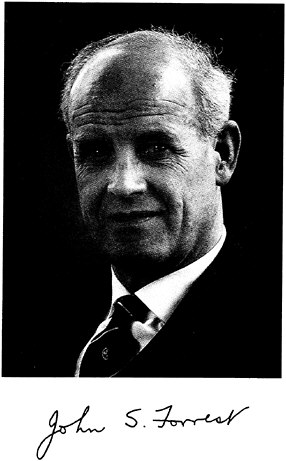JOHN S. FORREST
1907–1992
BY JOHN G. ANDERSON
JOHN S. FORREST, one of the principal leaders in electric power research in Europe and former vice-president of the Royal Society, died on November 11, 1992, at the age of eighty-five. He had been a foreign associate of the National Academy of Engineering since his election in 1979.
His career covered a broad spectrum of creative contributions to the design and performance of high-voltage transmission in Great Britain, development of high-voltage insulation, protection against lightning, enhanced reliability of electricity supply, environmental effects, and leadership in energy research in Great Britain and on the continent of Europe. Founder of the Central Electricity Research Laboratories (CERL) in Leatherhead, England, he led much of the development of the British 275-kV and 400-kV transmission systems, and his work has also been a major influence on energy system development in the Western world.
John was born in Hamilton, Scotland, on August 20, 1907. He graduated from Glasgow University in 1930 with M.A. and B.Sc. degrees in physics, and joined what was then the embryo Central Electricity Board in Glasgow. Within a year he joined the Central Electricity Board in London to take charge of their transmission research activities. He became one of the early pioneers in high-voltage insulation research in Great Britain at that time. From 1931 onward he researched the performance of outdoor insulators on lines and in substations of the British
132-kV transmission system, particularly subject to ice, snow, industrial contaminations, and salt storms common in coastal areas. His papers on insulation performance are still standard references today.
The Central Electricity Research Laboratories, founded in 1940, quickly became the principal research arm of the British electric power system and remains one of the leading electrical research laboratories in the Western world. The demands and problems that World War II imposed on the British electrical system, the shortage of staff and materials, and the energy demands for war production all made those early times at the CERL hectic indeed, particularly for John Forrest, its director. Shortly after the war he took time to complete his D.Sc. degree at Glasgow University, while he continued as director of the CERL.
His career from 1931 to 1973 spanned the growth of the British grid from 138-kV to 400-kV transmission capability. Pushing a transmission system into higher voltage levels is always attended by a proliferation of new electrical, mechanical, and environmental problems wherein the cost of poor decisions can be enormous. Often, little experience is available, and high-voltage and high-current research facilities are kept busy breaking new ground, testing new equipment, designing new conductors and hardware, and examining environmental effects. John led this work in Great Britain and was the author or coauthor of approximately eighty-five published technical papers and articles. He was a fellow and vice-president of the Royal Society, secretary of the Electricity Supply Research Council (London), visiting professor of the University of Strathclyde (Glasgow), chairman of the British National Committee of CIGRE (the International Conference on Large High-Voltage Electric Systems), and a fellow of the Institute of Electrical Engineers. He held several patents, including a device to locate distance to thunderstorms, an improved high-voltage insulator design, a method of testing energized line insulators, and a substation protective system.
After forty years of contributions to high-voltage research and service to the supply industry and to electrical power engineering, John Forrest retired from CERL in 1973. However, he
continued to contribute to the Royal Society as a vice-president and as an active distinguished lecturer on electricity supply matters and high-voltage physics. He also continued his participation in engineering education at the University of Strathclyde for several years.
John Forrest started his technical and managerial career in the early 1930s when our knowledge of lightning, insulation behavior, and design of electric supply was chaotic at best. When he ended his career in 1992, he left power system engineering a legacy of new concepts and new operational standards and methods that will survive well into the next century. Men like him are rare indeed.





